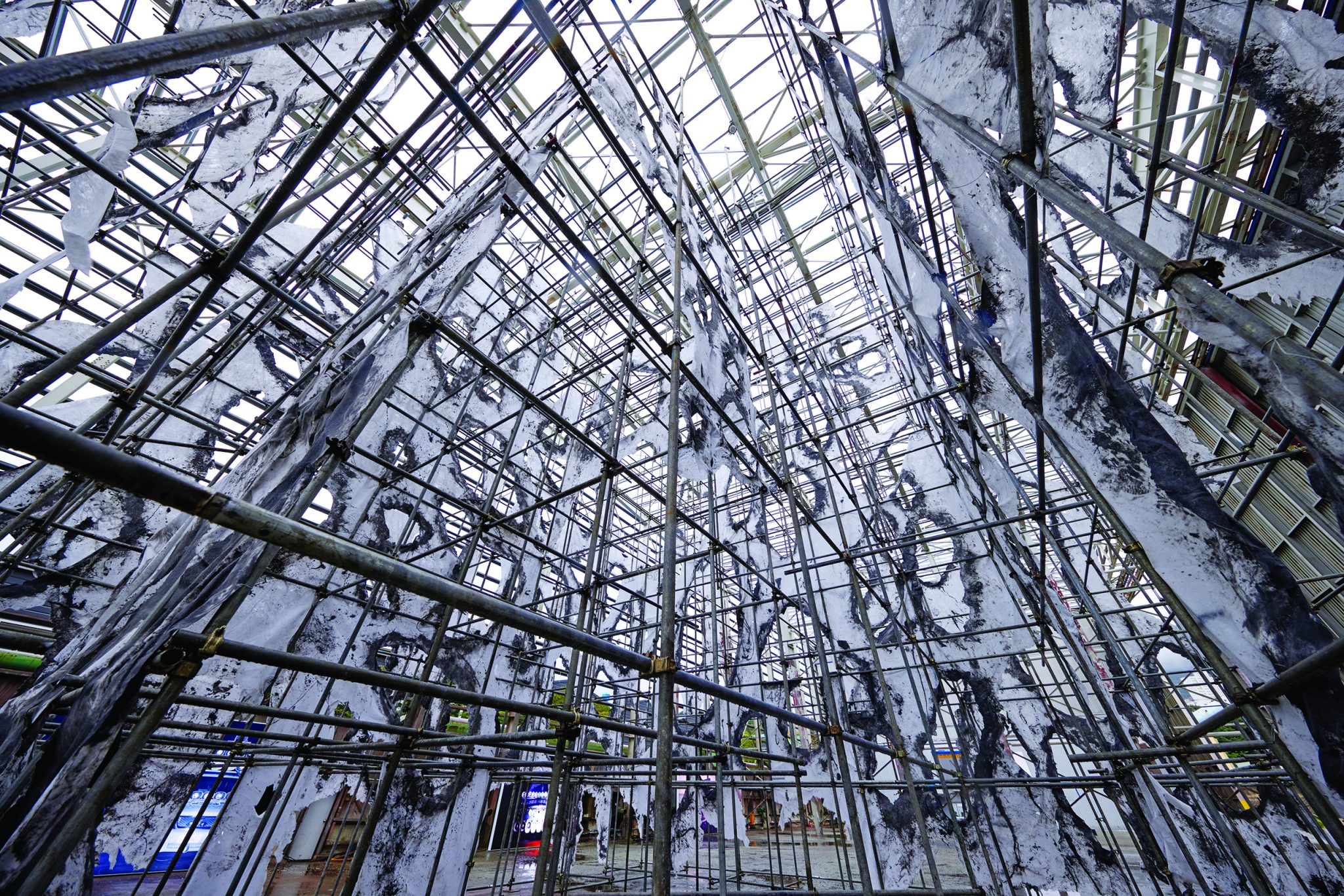The Korean artist’s haunting, lo-fi kinetic sculptures offer new spins on sensing and thinking, and perhaps new ways of being
As instructed by a sign, I lift a piece of resin-coated burlap attached to a black metal frame. Beneath the flap is the following poem: ‘Poetry that turns to / shit outside the / body, love that turns / to shit Look, I’m / a fountain of filth / raving mad with love / Let’s sing with a face that’s bitten half off / That’s half bitten off / A crazed, lovestruck / song.’ It’s written in lead.
Four other such poems hang on two freestanding red-stained wooden walls. The room stinks – of resin, of dust. Nearby, three concrete mixers turn sporadically, raucously tumbling their contents (which in one case includes steel cable and crusty fabric; plaster rocks stuffed into construction gloves in another). I jump every time they turn on.
Next to one mixer hangs Untitled (burlap body piece with many holes) Concrete version (2024), a giant looping structure made of burlap sturdied with concrete and suspended from the ceiling by a metal chain. It’s wide at the top, narrow at the bottom, like a cow’s carcass. Untitled (burlap body piece with many holes) I (2024), a similar, smaller sculpture – albeit made with dried clay instead of cement – sits atop a wood panel. I learn that the poems are written in lead after lifting the burlap with my bare hands; not only are the words poignantly seared into my brain, the sounds and smells into my body, but so too is a potential threat, a poison. (When I visit the gallery a second time, gloves are sitting on a windowsill next to the instructional sign.)
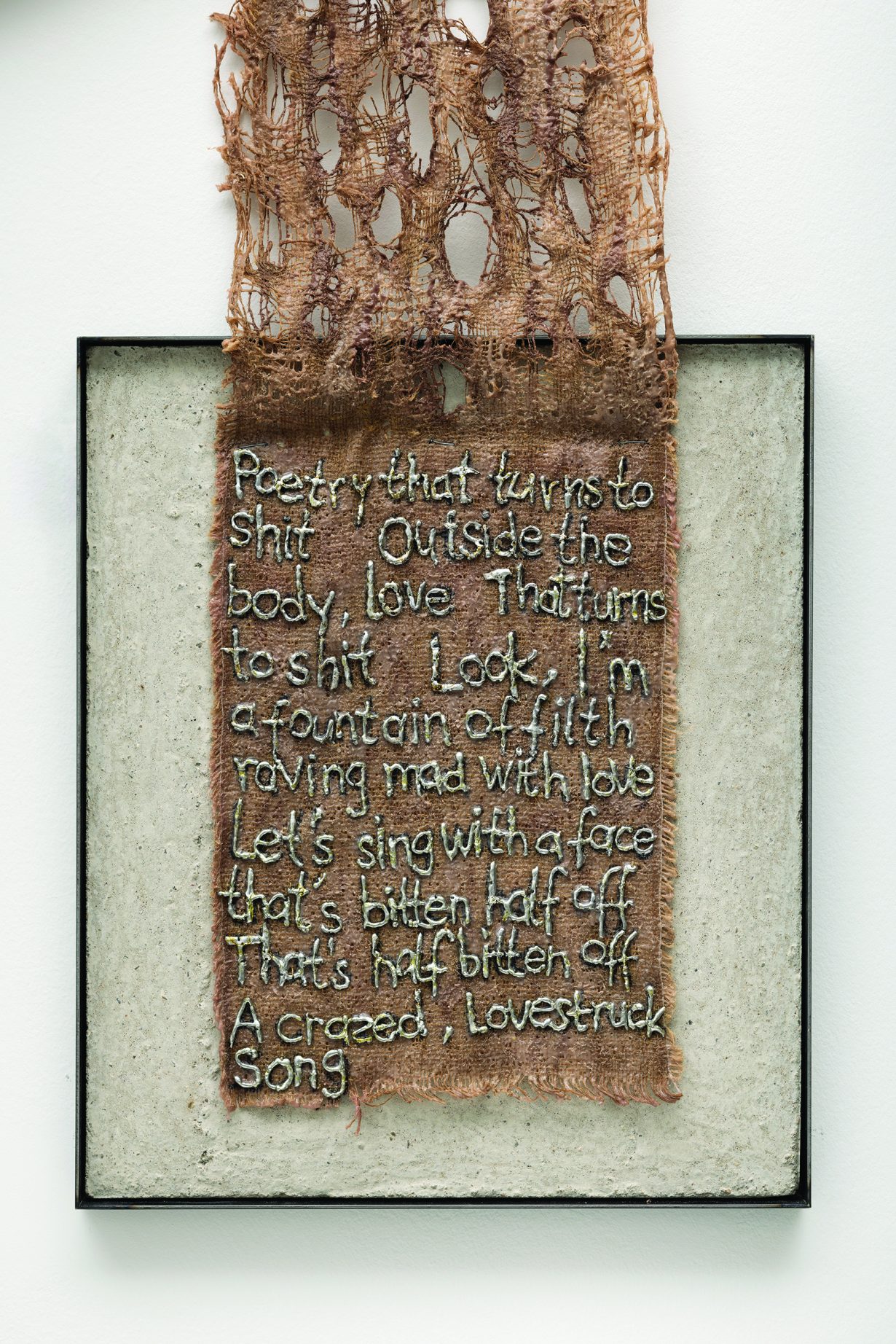
This constellation of works by the Seoul-born, Berlin- and Amsterdam-based artist Mire Lee consumed a room at Sprüth Magers’s gallery space in Berlin this summer. The poems are by Kim Eon Hee, who is known for her unconventional use of language and the grotesque forms she describes. Lee has worked with Hee multiple times, and the two of them are even translating a book of Hee’s poetry into English for the first time. “I love [her poetry] for not being fully containable,” Lee says when we meet at her studio in Berlin, “and I admire and aspire to the type of art that is not containable.”
Over the past eight or so years, Lee has produced sculptures and environments that are, indeed, far from containable. Her lo-fi works – pairing motors, tubes and pumps with silicone, wet and dried clay, and viscous liquids – often rumble, bleed, twist or turn, situating their maker in a lineage of kinetic artists and those who have offered unsettling takes on the human body, not least fellow Korean Lee Bul (though Lee operates at some distance from Bul’s dark cyborg figures and takes on utopian architecture). Indeed, Lee’s artworks can be hard to position because they change over the course of their lives, sometimes deteriorating altogether. At the 2022 Busan Biennale, she erected a 21-metre-tall scaffolding structure, covered with holey, construction-site fence mesh; the voids in that mesh are outlined in black by waste oil, as if an inky parasite had been eating away at the fabric, as if the holes would continue to grow ever larger (Landscape with Many Holes: Skins of Young-do Sea, 2022). At the Venice Biennale that same year, Lee adorned more scaffolding with sinuous ceramic sculptures and hoses from which lithium carbonate and iron-oxide glaze spurted, pushed out by unseen pumps (Endless House: Holes and Drips, 2022). Dripping with the deep red liquid, the ceramics and hoses appeared like disembodied organs, bones and guts, the installation a biomorphic entity both beautiful and grotesque, amazing and repulsing.
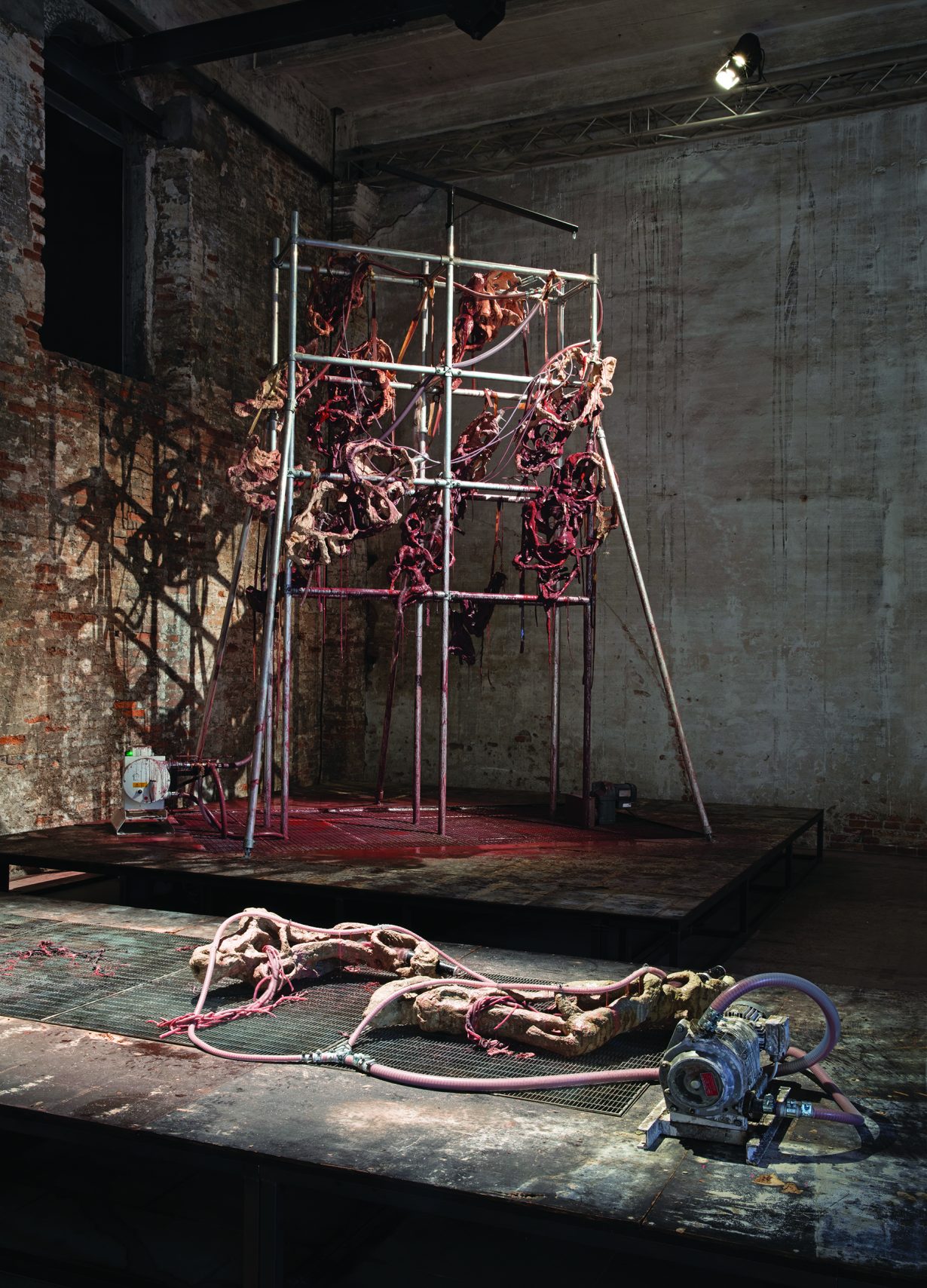
Lee began working with kinetic sculpture in Amsterdam, where she moved in 2018 for a residency at the Rijksakademie after receiving her BFA and MFA from Seoul National University. There, she took an Arduino programming course and was immediately drawn to the unpredictable results of using motors and machines in her sculptures. “I fear myself being comfortable,” she explains, “and because a kinetic object is moving, it’s like a translation of that existential angst, of wanting to be able to be surprised and to surprise myself.”
When beginning something new or moving from one project to the next, Lee starts with simple associations, admitting, “I don’t really have a conscious process.” She fluidly follows one thought or material to the next, digesting and instinctively abstracting associations and any additional references as she creates, until she feels, in her gut, that a work is finished. Often, any explicit reference appears only in a work’s title: Veronica Moser (2022) is a found video-interview with the eponymous late pornography actress who specialised in scatology; the title of Lee’s exhibition at the New Museum in New York, Black Sun, was pulled from philosopher Julia Kristeva’s 1987 book Black Sun: Depression and Melancholia; and the aforementioned title of her piece for the Venice Biennale nods to architect Friedrich Kiesler’s 1959 Endless House, an unrealised vision of an orifical building. But beyond such titular hints, references are fully abstracted, a point underlined during my conversation with the artist, when these overt allusions bleed into many others unseen. When Lee speaks about Kiesler’s house, for instance, it gives way to the ‘Josef Fritzl Haus’ (specifically, a part of the cellar that Fritzl, a notorious Austrian sex criminal, built and adjusted over time to imprison his daughter in order to repeatedly rape her, and where she eventually gave birth to seven babies), which gives way to the improvisational and layered nature of certain traditional architectures in South Asia, which then leads to musings on Lee’s own childhood bedroom.
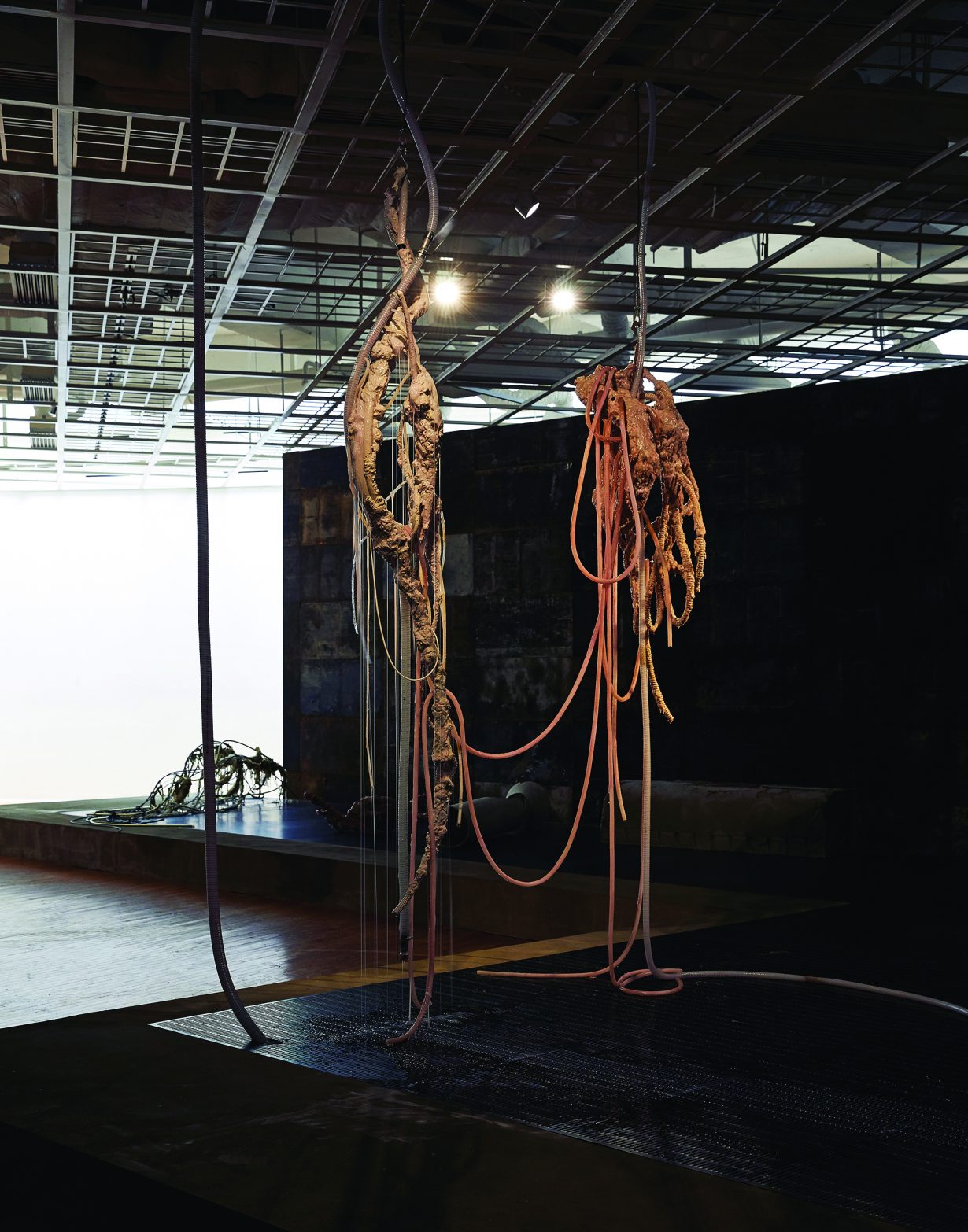
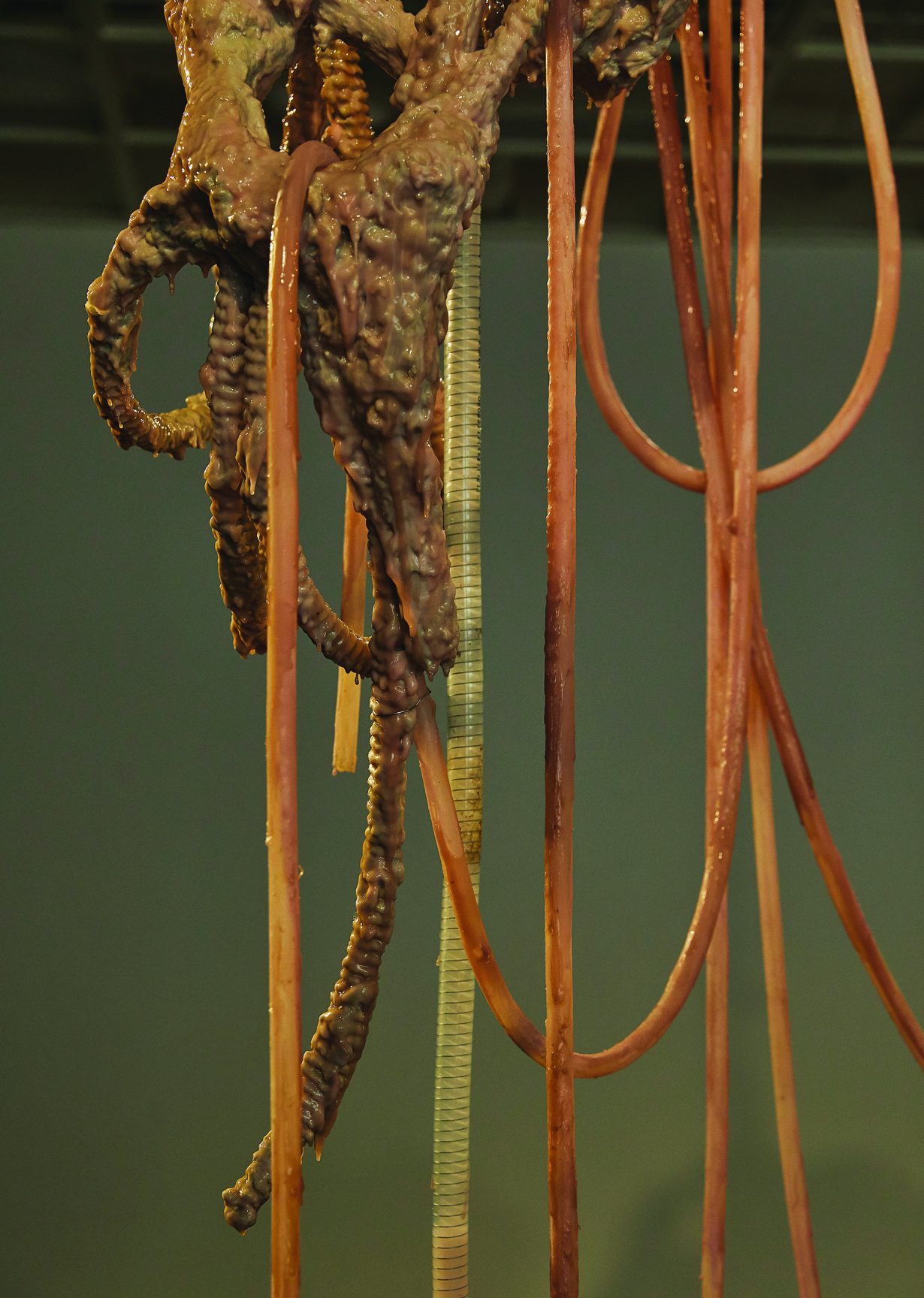
Follow the clues Lee gives in her titles (which means a little research) and similar streams of potential references can be discovered. Both the title of the work and a brief text accompanying the work in Busan, for example, indicate that she took as her starting points Yeong-do, or Yeong Island, and the abandoned Songkang Heavy Industrial Co, Ltd factory, where her piece was installed. After a quick google search, it becomes clear that the island was a home for refugees and displaced people after the 1930s, a time during which Japan ruled Korea under a strict military regime and enforced cultural assimilation. I also learn that in 1932 the Japanese military began forcing Korean women from their colonies to become sex slaves. The disused factory, meanwhile, speaks to a history of failed industrialisation. But this information is neither explicitly detailed in relation to Lee’s work nor aesthetically part of the installation, a conscious choice by the artist to prioritise affect over didacticism. First and foremost, the work made the imposing building feel forlorn, the installation and factory itself both fragile entities on the brink of collapse; in turn, this engendered an acute awareness of the relative smallness of the human body, and of one’s own mortality.
When we meet, Lee is preparing for a forthcoming commission at Tate Modern’s Turbine Hall. For it, she began with basic associations related to the space’s history as part of a power station. She then reckoned with its monumentality and what she describes as its “masculine feeling”. The details of the installation remain a secret, but broadly, as in Busan, Lee aims to undermine the scale of the location by presenting an incredibly large work that simultaneously feels fragile or small: “I really like to make sculptures look sad,” she explains. “If a sculpture is very small compared to the physical environment, or if it’s not erect but on the ground, it’s immediately a bit sad. I have always enjoyed when [a sculpture] can create a certain mood or affect but in a very simplistic way.”
Regardless of a sculpture’s location or potential reference points, Lee’s work evokes raw emotion – in herself and, in turn, in the viewer. And this connects directly to her fear of being comfortable, of entering a state of stasis: “I fear that [if I were comfortable] I would become judgemental and exclusionary,” the artist further explains. “I want to feel as many things as possible,” she continues, while discussing the process of creation. In doing so, by creating works that are jarringly uncontainable and unpredictable, Lee likewise pulls the viewer out of their own ordinary – their daily – rhythms, offering instead an experience to see, to smell, to hear – to feel – anew.
Mire Lee’s Hyundai Commission at Tate Modern’s Turbine Hall, London, is on view from 9 October to 16 March
